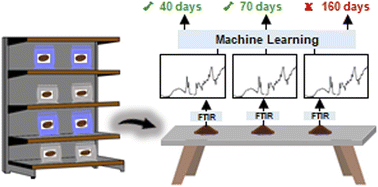Characterization and predictive modeling potential of aging time of roasted coffee using infrared spectroscopy
Abstract
Repackaging and tampering with labels of foods to extend their shelf life is an illegal practice, increasingly common in some Brazilian coffee retail markets. Fast, easy-to-use, and low-cost analytical techniques for the large-scale screening of aging time have been demanded lately to fight the growth of these frauds in retail coffee markets. In this work, Fourier transform infrared spectroscopy was evaluated as a provider of relevant regressors, chemically explainable, aiming for predictive models for estimating the aging of roasted and packaged coffees during their shelf life. Spectra of two Coffea arabica varieties (Bourbon and Obatã) were periodically acquired during eleven months of storage. The most relevant absorption bands were selected, which showed a moderate correlation with the storage time. They were identified as responses from lipids, phenolic compounds, and carbohydrates. From those responsive bands, logistic regression (sigmoid functions) models were fitted for each coffee variety, as well as for both together. Predictive models for Bourbon and Obatã showed high performances in validation data, with r (Pearson correlation) above 0.92 and root mean square error (RMSE) below 43 days. For both varieties, the logistic model showed r greater than 0.83 and RMSE equal to 56 days. Results corroborate the methodological approach efficacy towards agile technological innovations in the coffee value chain, as well as opening new application fronts for estimating the aging of other foods.

- This article is part of the themed collection: Analytical Methods HOT Articles 2022


 Please wait while we load your content...
Please wait while we load your content...